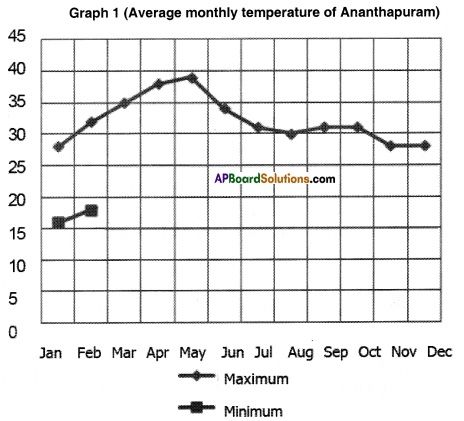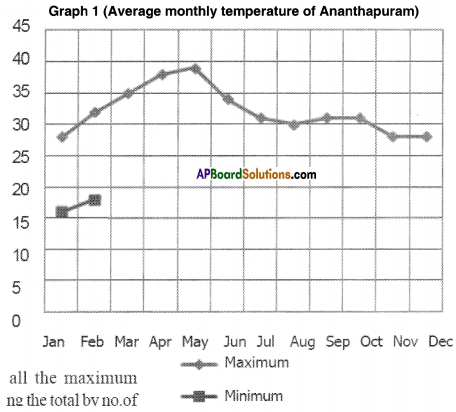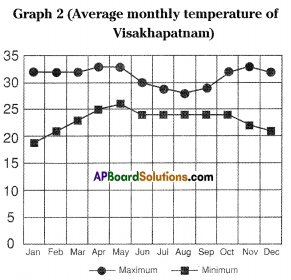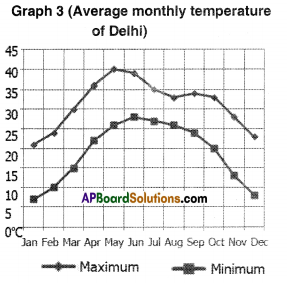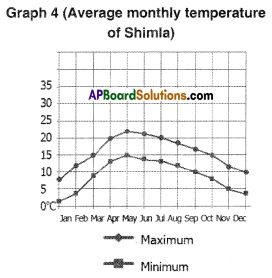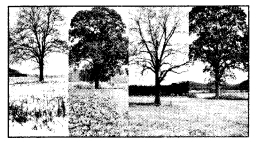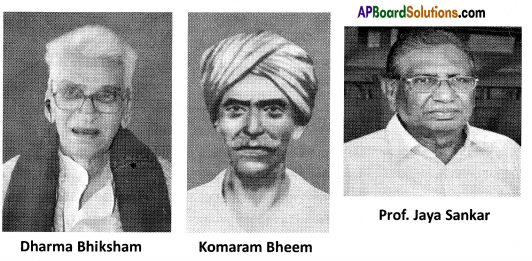SCERT AP Board 8th Class Social Solutions 16th Lesson Abolition of Zamindari System Textbook Questions and Answers.
AP State Syllabus 8th Class Social Studies Solutions 16th Lesson Abolition of Zamindari System
8th Class Social Studies 16th Lesson Abolition of Zamindari System Textbook Questions and Answers
Improve your learning
Question 1.
When laws are passed in the Assembly, there is much discussion on it from different points of view. What would have been the different points of view regarding the Land Reform Act in the 1950s? Which point of view would have been stronger?
Answer:
Different points of view:
- Zamindari system should be abolished.
- Zamindars should be compensated.
- Land should be given to the poor for cultivation.
- Tenants should be the owners of their land.
- Vetti/Begar should be abolished.
- Large tracts of waste land should be redistributed to the poor.
- Tax collection authority should be in the hands of government.
- Peasantry should be protected from landlords.
Stronger point of view: Put an end to the rural poverty.
![]()
Question 2.
What would have been the points of view in 1970s when the Land Ceiling Acts were passed?
Answer:
Points of view:
- All the wealth in the nation is centralised in some hands only.
- Many small farmers are the owners of small land holdings.
- Many Daliths are landless.
- Big buildings, cattle sheds and agriculture implements were left in the possession of the erstwhile landlords.
- Zamindars were changed as landlords and landlords as industrialists.
Question 3.
Do you think the peasant women gained from these reforms in any way? Give your reasons.
Answer:
We can say that they gained something.
Reasons:
- Some landlords and big farmers transferred the surplus lands to their family women.
- There were also instances where fictitious divorces were taken in law courts to show husband and wife as separate families. Thus they owned lands.
- Women also worked in fields with their husbands for coolie. But now they started working in their own fields.
![]()
Question 4.
Why was the end to vetti important for all kinds of peasants? What would the landlords have done to cultivate their lands now?
Answer:
‘Vetti’ is a black spot for humanity. Many struggles were led against this. So the end of it was important for all kinds of peasants. In olden days, there were no landlords as they are now. They appointed ‘Palers’ and ‘Coolies’ in their lands to work during cultivation.
Question 5.
Imagine that you are a tenant who got ownership over land when the Land Reform Act was implemented. Write down your feelings.
Answer:
“I got 4 acres of land according to this Act. I paid some amount for this. Till now I and my family members worked hard in our Dora’s fields. But from now onwards I am the owner of this land. We, the family members, work hard in our own field. We are so happy. We breathe- in the air of independence”.
Question 6.
Imagine that you are a landlord at the time of Land Reform Act. Describe your feelings and actions at that time.
Answer:
“Alas! Today is a bad day for us. I lost my 4000 acres of land. Till now my house is filled with bags of grains, wealth, servants and vetti people. But now I lost everything. By playing many tricks, I saved only 150 acres of land.
I feel very happy to see independent India but I lost all my wealth. How can we lead our life without wealth and power?”
![]()
Question 7.
Many people feel that the land reform actually harmed a large number of tenants – at- will. Do you agree with this view? Give reasons.
Answer:
I do agree with this to some extent.
Reasons:
- Some tenants paid the price fixed by the government and owned their land.
- Thousands of poor peasants could not pay the price or did not have legal recognition as tenants.
- Zamindars retained control over their Khudkasht lands and declared their tenants to be labourers.
- They also evicted a large number of tenants to take over their lands for self-cultivation.
Question 8.
Why was the Land Ceiling Act not implemented effectively even though the govern¬ment tried to make effective laws?
Answer:
The Act could not be implemented properly due to machinations of the landlords and also lack of sufficient political determination on the part of the government.
Question 9.
Why do you think the spirit of Bhoodan did not help to end landlordism and get land to the tiller?
Answer:
In this movement, the landlords should donate their land with their own interest. This kind of humanity was not in them. Some of them donated only ‘Banjar’ and ‘Porambok’ lands only instead of cultivated land. 90% of the fertile lands remained with the landlords. So the movement did not help to end landlordism and get land to the tiller.
![]()
Question 10.
Locate Pochampally village in Nalgonda district in combined Andhra Pradesh map.
Answer:

Question 11.
Read the first paragraph under heading ‘Rural Poverty at the time of Independence’ and answer the following: Are the conditions improved now? In what way?
Answer:
We can say that the conditions are improved now.
They are working as industrial labours also. They are leading their lives by working in laying roads, making of handicrafts etc. They are going to schools also. The agricultural labourers have a better demand now. Thus their conditions are improved.
![]()
Question 12.
Form a group of five students each. Discuss the experiences of elders of your area about the land ceiling. Know out whether the issue happen in that village as mentioned in the chapter. Prepare a report and submit in the class.
Answer:
Report
We met 15 elders in this project. With this Act many were turned as beggars, some were escaped.
Some transferred the ownership of the lands to their relations, friends, labourers etc., and saved their properties. Some lost everything with this Act. They cried a lot.
On the whole the Act caused relief to some and pain to some.
8th Class Social Studies 16th Lesson Abolition of Zamindari System InText Questions and Answers
Question 1.
While the slogan ‘Land to the Tiller’ meant that the tenant will get the land, what will happen to the landless agricultural worker, who works for wages? (Textbook Page No. 185)
Answer:
The conditions of the tenants were somehow improved. But the conditions of the landless agricultural workers remain the same. They are still in the same poverty.
![]()
Question 2.
Some people feel that the land reform laws only tried to help the landlords. Do you agree with them? (Textbook Page No. 186)
Answer:
Yes, I agree with them.
Giving compensation to the Zamindars, continuing them as owners of the Khudkasht etc., reveal this.
Question 3.
Some people feel that the land reform laws tried to transfer land and power to prosperous tenant farmers only. Do you agree with them? (Textbook Page No. 186)
Answer:
Yes, I agree with them. The reason behind it is the government made a rule that the tenants would be given land only if they paid some price for it. Those peasants who could pay became the owners of the land. Rest of them were remained as poor only.
Question 4.
Some others feel that the laws tried to strike a balance between the interests of different rural groups in order to minimise internal conflicts. Do you agree with them? (Textbook Page No. 186)
Answer:
Yes, I agree with them.
According to these laws, the Zamindars became landlords, some tenants became land owners and some poor became owners of banjar lands. So we can say that internal conflicts were minimised.
![]()
Question 5.
Some people think that it should have been implemented in 1950 while others feel that such a measure would have caused a lot of opposition. Discuss the two views in the class and decide which view you agree with. (Textbook Page No. 190)
Answer:
It is very difficult to implement these laws in 1950. “Acquisition of that much land from the owners, that too immediately after independence there might be a chance of inner conflicts and strong opposition. But there were many leaders like Sardar Vailabhai Patel. The government might meet the challenges arisen. So I also think that it should have been implemented in 1950.
Question 6.
Compare the implementation of Land Ceiling Act in West Bengal and in Andhra Pradesh discuss how the Act could be effectively implemented. (Textbook Page No. 191)
Answer:
We can say that the Act was implemented in a mean way.
Several landlords gave false declarations to the officers and did not reveal the excess land. Anticipating the Act several landlords transferred their lands in the names of their close relatives, friends, and even farm servants. There were also instances where fictitious divorces were taken in law courts to show husband and wife as separate families. In this way even those farmers who had surplus land as per the Act protected their lands and did not show any surplus. Some of the surplus land that was taken over by the government was not fit for cultivation.
One of the states in which the Land Ceiling Act was more efficiently implemented was West Bengal. The West Bengal government acted with great determination and mobilized the landless and small peasants to participate in the implementation of the ceiling laws.
The Act could not be implemented properly due to machinations of the landlords and also lack of sufficient political determination on the part of the government.
![]()
Question 7.
Do you think there was any other way of giving gainful employment to the rural poor? (Textbook Page No. 185)
Answer:
At present there are many ways of giving gainful employment. But there were less opportunities at that time. The British destroyed the occupational system of India. The people lost all their chances of employment. So I think there were no other ways.
Question 8.
How many acres of land does a family of four persons need to get a decent living in your area? (Give the figures separately for both irrigated and unirrigated land.) (Textbook Page No. 185)
Answer:
A family of four persons needs 8 acres of irrigated land and 30 acres of dry land to get a decent living in our area.
Question 9.
Who gained most and who did not gain at all? Do you think the landlords lost much? (Textbook Page No. 186)
Answer:
Zamindars gained most.
Reasons:
- Even though they lost their income, they received 20, 30 times to that as compensation.
- ‘Khudkasht’ lands were also under their control.
- They used various loop holes in the law to retain control over large portion of land. The poor did not gain at all.
Reason: They remained unrecognized and as agricultural labourers.
Question 10.
Which sections of the peasants of Telangana gained from the various reforms? In what ways did they benefit? (Textbook Page No. 189)
Answer:
From the various reforms in Telangana the landlords and the ryots of some castes gained.
- The dominant sections of the cultivating communities of these jagirs got patta right on lands.
- Jagirdars received crores of rupees as compensation.
- Big buildings, cattle sheds and agriculture implements were left in the possession of the erstwhile landlords.
- Thousands of acres of fertile land also remained with them as Khudkasht lands.
So we can say that feudalists gained much.
Question 11.
To what extent did the landless service castes benefit from these reforms? (Textbook Page No. 189)
Answer:
They were not benefited in any way from these reforms.
![]()
Question 12.
To what extent did the landlords loose and to what extent did they manage to protect their interests? (Textbook Page No. 189)
Answer:
We can say that landlords lost nothing.
Many of the laws were implemented tardily. Due to the delay in implementation the large landlords used it to their best advantage. Using the loop holes in the Tenancy Act the Zamindars regained control over the lands from the tenants. The Zamindars after abolition continued as big landlords claiming the land as their own. These lands were diverted to set up industries. For example, the Challapalli Zamindar showed 2650 acres under his sugar factory. But eventually they transformed as entrepreneurs in Andhra. But in Telangana they continued their domination into the twenty first century.
Question 13.
Observe the following table and fill in the blanks. (Textbook Page No. 189)
The Structure and Distribution of Landholdings in Andhra Pradesh, 1956-2006
Source: Directorate of Economic and Statistics (DES), Hyderabad.
| 1955-56 | 1980-81 | 2005-06 | ||||
| Share in no. of landholdings | Share in cultivated area | Share in no. of landholdings | Share in cultivated area | Share in no. of landholdings | Share in cultivated area | |
| Small 0-2 hect. | 58% | 18% | 73% | 29% | 83% | 48% |
| Medium 2-10 hect | 32% | 44% | 25% | 52% | 16% | 46% |
| Large 10 above hect. | 10% | 38% | 2% | 19% | 1% | 6% |
| Total | 100% | 100% | 100% | 100% | 100% | 100% |
Answer:
Reading the table: Read the figures for the year 1955-56 carefully. It tells us that, after the land reforms had been implemented 58% of farmers were small farmers with less than 2 hectares of land each. Even though they formed more than half of all farmers, they had less than 20% of cultivated land. On the other hand you can see that large farmers or landlords who were only about 10% of the farmers had about 38% of all cultivated land.
After the land ceiling was implemented in 1970s see the changes that took place. The number of small farmers who were …58..% increased/decreased to …83.. %. Medium farmers now were less in number and controlled …32% to 16..% more/ less land than before. Large landowners declined to less than …1.. % but still owned about …6.. % of land.
Question 14.
Why did the Land Ceiling Act become necessary? (Textbook Page No. 190)
Answer:
Many Acts after independence have not changed the ownership of lands in India. It changed Zamindars as landlords, landlords as big farmers. But it did nothing to the common poor.
The ownership of the land was only a few hands. So the Land Ceiling Act became necessary.
![]()
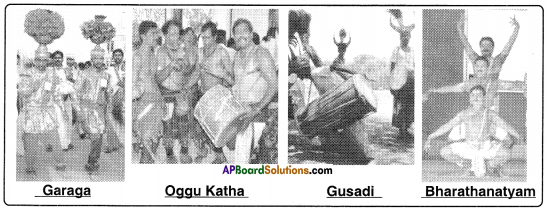 Above are some photos of performing arts. How many of them can you identify? Write down the names below each of the photos. (Textbook Page No. 227)
Above are some photos of performing arts. How many of them can you identify? Write down the names below each of the photos. (Textbook Page No. 227)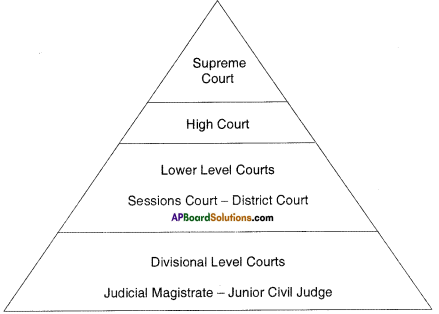

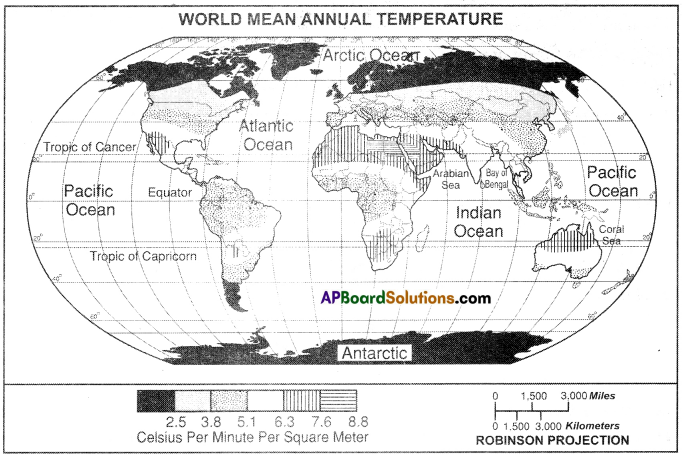 1. What is the line to south of equator?
1. What is the line to south of equator?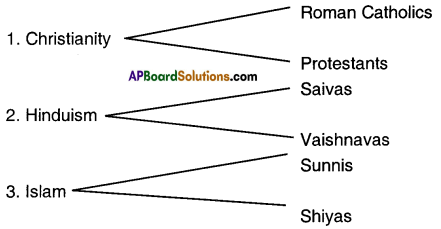
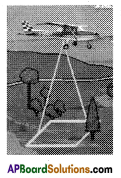

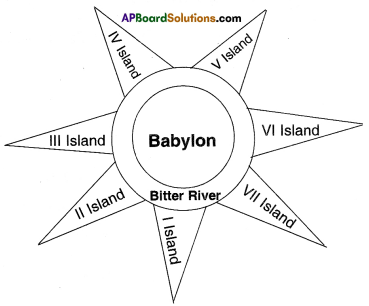 The Babylonian clay tablet was dated from the Persian period. It was flat and round. The inner circle had all the places they knew about. The city of Babylon was shown in the middle. Beyond the inner circle was ‘Bitter river, or ‘Salt water ocean’ in which were seven triangular islands.
The Babylonian clay tablet was dated from the Persian period. It was flat and round. The inner circle had all the places they knew about. The city of Babylon was shown in the middle. Beyond the inner circle was ‘Bitter river, or ‘Salt water ocean’ in which were seven triangular islands.

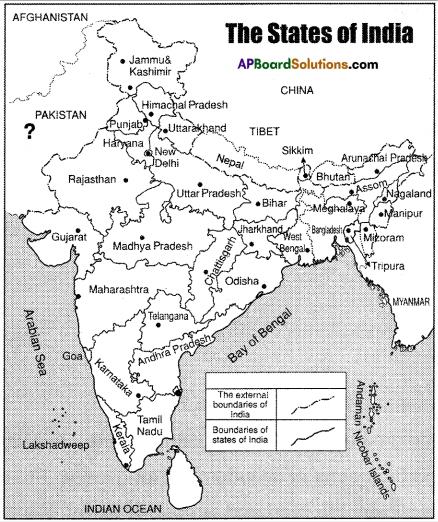
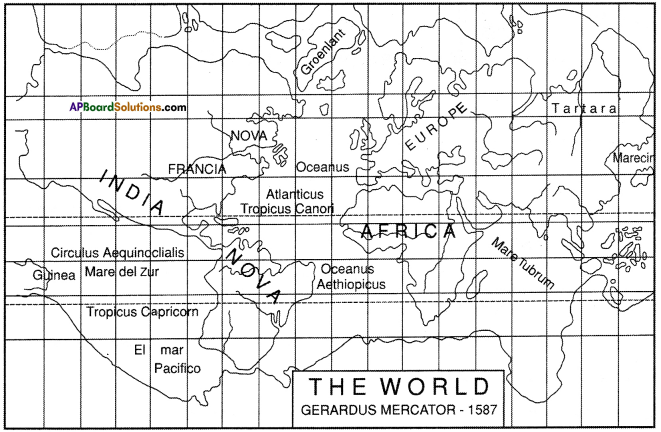
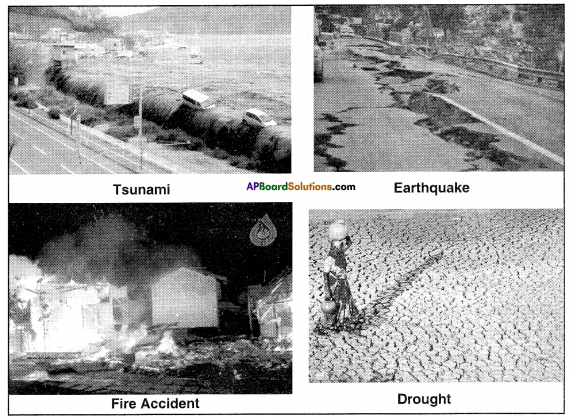


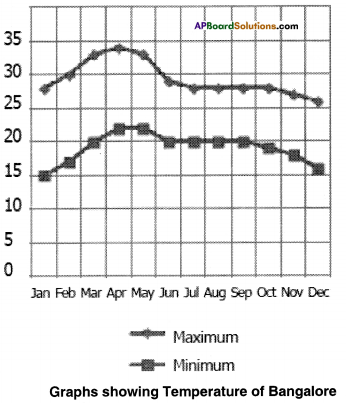 a) What is the average highest temperature in July?
a) What is the average highest temperature in July? Radiation: When a body gives out energy it is called radiation.
Radiation: When a body gives out energy it is called radiation.
